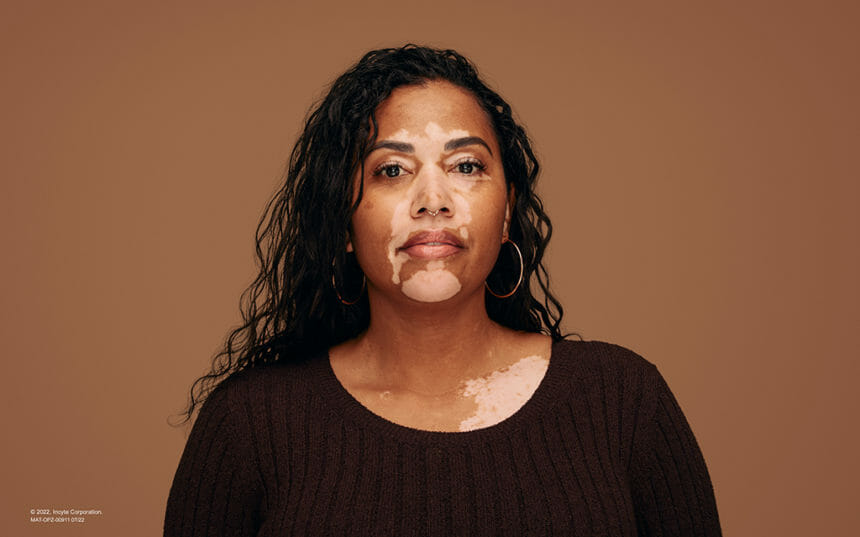Incyte’s Opzelura picked up an approval from the Food and Drug Administration for use in patients with vitiligo Monday, making it the only approved therapy for the pigmentation disease in the U.S.
Incyte can now market the medicated cream, which secured an initial green light in atopic dermatitis (AD) last September, for a second indication. Despite having first-mover status, however, activating the vitiligo patient community won’t be easy.
Vitiligo is a chronic autoimmune disease characterized by depigmentation of skin on the face and other areas of the body. It’s believed to affect approximately 2 to 3 million people, more than 1.5 million of whom have been diagnosed, according to the Vitiligo Research Foundation.
In a Phase 3 clinical trial, Opzelura (ruxolitinib) was shown to help about 30% of patients regain more than 75% of their natural pigmentation in the facial area by the six-month mark, versus approximately 8% and 13% of patients treated with placebo. Improvements grew to 50% of patients by the one-year mark and the cream proved easy to apply and well-tolerated.
Still, Incyte anticipates that just 150,000 U.S. vitiligo patients are currently seeking treatment. That’s because many people affected by the disease have grown “disappointed and frustrated” from using available therapies, the company said.
“One of our largest hurdles is activation of the patients,” acknowledged Todd Edwards, Incyte group VP, business unit head, inflammation and autoimmunity, on a call with analysts Tuesday morning. “These patients have had no viable treatment option since their time of diagnosis.”
Treatments have ranged from narrow-band UVV to eczema-laser phototherapy to a combination of other prescription medications, until now used off-label. Monday’s FDA approval allows Incyte to market Opzelura as a monotherapy for repigmentation in patients with non-segmental vitiligo, the most common type.
“This is a stigmatizing, challenging condition,” added Dr. Seemal Desai, a vitiligo specialist who is a clinical assistant professor of dermatology at the University of Texas Southwestern Medical Center, also on the analyst call. “It’s tough to treat. Many of these patients often lose hope.”
To bring them back to the clinic, the company is betting on a variety of strategies. The vitiligo launch involves priming patients for effective and productive conversations with their HCPs. This ensures potential patients are able to access Opzelura and understand that the repigmentation process is a gradual one, Edwards explained.
Tactically, this will be supported on the patient side by Opzelura.com and a CRM program that engages patients through email, text and direct mail, he said, adding that the media campaign will include social media. Incyte also created a mobile app and patient journal to help with understanding the treatment journey, expectations and compliance.
That’s on top of awareness efforts that include working with patient advocacy groups as well as educational resources, co-pay mitigation and other support programs to drive access.
“We expect to start TV and DTC early next year,” said Edwards.
The 150,000 who are diagnosed with the disease may be “more inclined to see their dermatologist or to become aware of Opzelura,” he continued. “However, there are others who have stopped seeking treatment and it may take time to become aware of therapy, schedule a visit with their dermatologist and then make a decision to seek treatment or not.”
Analysts have tempered their Opzelura revenue forecasts accordingly. “We believe demand could rapidly fall short of that necessary to make Opzelura a blockbuster drug,” wrote Andrew Berens of SVB Securities in a May analyst note.
It’s not that the AD launch hasn’t been going better than expected. Revenues in the first quarter were $12.8 million, beating consensus of $9.4 million by 36%, according to SVB Securities.
Moreover, along with the vitiligo approval came a broader label. Whereas Opzelura was restricted to short-term, non-continuous approval in AD, in vitiligo it’s been greenlit for continuous use on any part of the body with no limit on duration of use as long as patients continue to see benefit.
The FDA also updated the black box and safety warnings to more specifically distinguish serious adverse events related to topical JAK inhibitors like Opzelura from the oral kind.
The “better-than-expected Opzelura launch could be a near-term boon” and the broader labeling should put physicians at ease, wrote Berens. However, he still harbors “concerns that the company’s $1.5 billion peak guidance for Opzelura in AD in the U.S. (not including EU or vitiligo) seems ambitious.”
On Tuesday, the analyst issued an updated forecast: peak revenues of $271 million in vitiligo by 2030 and total peak Opzelura revenues of $673 million for the same year. The company anticipates EU approval in the first six months of 2023, although it’s not currently seeking approval there for AD.
Additionally, a broad, multichannel marketing approach is planned for physicians to educate them on the drug’s clinical profile.
Nonetheless, “With [Incyte] primarily marketing Opzelura to high-prescribing dermatologist offices, we believe the launch could rapidly plateau,” Berens wrote.
Indeed, it will take a great deal of commercial work to convince vitiligo patients to return to seek treatment, even with the availability of a new option with proven efficacy data.
“We have an unprecedented opportunity here with the uniqueness of Opzelura,” said Edwards. “However, it’s difficult to predict the speed of launch or the bolus of patients.”







